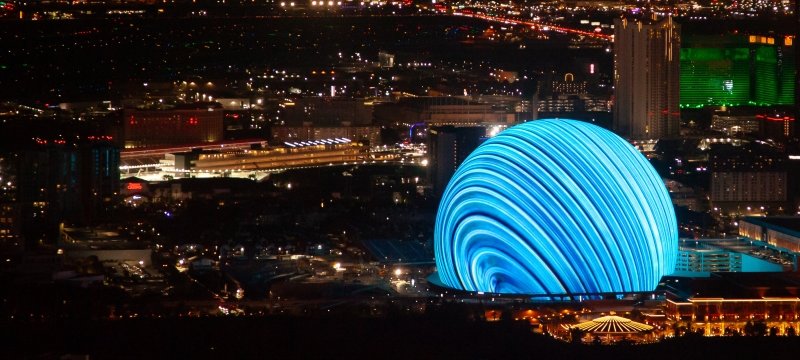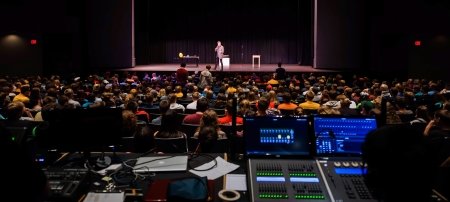Sphere is the hottest new attraction on the global entertainment scene — and five Huskies had a hand in its creation.
“We're the center of the brain,” said Paul Bristol, a 2016 Michigan Technological University graduate who’s now a design engineer for technical consulting firm Smart Monkeys Inc. and served as a principal design consultant to the Sphere Entertainment team for the Las Vegas attraction’s control system. “Whenever someone presses on a button, we help make sure that what needs to happen does.”
Smart Monkeys, one among a vast ecosystem of companies who worked with Sphere Entertainment on the $2.3 billion project, is no stranger to the world’s best-known and emerging entertainment venues — or Michigan Tech. Bristol’s career path was set as a first-year student in Tech’s visual and performing arts program after 2009 alumnus Mitch Schuh, now chief technical officer of Smart Monkeys, came up to talk to students about the company. Specializing in audio-visual control design, implementation and support, Smart Monkeys works with a broad range of venues, from museums to theme parks.

“I said, ‘I want to do that,’ and picked the recommended majors in audio production and computer engineering,” Bristol recalled.
Smart Monkeys handles large-scale projects like technology for Radio City Music Hall shows, along with smaller but still complex installations that focus on architecture (architainment), education (edutainment) and other experiential media environments. Their projects include work at Universal Entertainment’s Universal Orlando and Warner Bros. World Abu Dhabi.
Sphere is their biggest project yet. The attraction, now a focal point on the Las Vegas Strip, includes The Sphere Experience, which uses technology to blend science and art in ways that create new experiences in audience immersion and interaction. Visitors can chat with Aura the robot and capture their 360-degree avatars before settling into the main bowl — with haptic seating for 10,000 — to take in the world’s first multisensory film, complete with weather effects.
MTU Sound Program Alumni Working Together
In addition to Bristol, Tech graduates who worked on Sphere include:
Software Architect: Mitch Schuh, a 2009 graduate majoring in electrical engineering technology with a minor in music technology, is CTO at Smart Monkeys.
Design Engineer: Eric Smith, a 2018 graduate majoring in audio production and technology, is a project engineer at Smart Monkeys.
Project Engineer: Renata Putzig, a 2015 graduate majoring in electrical engineering and audio production and technology, is a project engineer at Smart Monkeys.
Systems Engineer: Nate Hunter, a 2013 graduate in audio production and technology, is a senior systems engineer at 7thSense.
Designwise, Smart Monkeys’ portion of the project began in fall 2019, including creation of a 200-page narrative followed by a two-year planning phase with a multitude of vendors, developing hooks for software and making the various elements cohesive. “The biggest challenge was thinking holistically about something no one’s ever done before,” Bristol said. Looking at the empty shell was daunting. “Radio City is 6,000 capacity, which is massive. But this is 20,000 capacity with seating and standing. I didn’t know what I was getting myself into,” he said, laughing.
Working on the design of an immersive experience also has an interesting side effect. “It’s a sensory experience working on it. And it does take over your senses,” he said.
There’s a long list of firsts inside and outside the largest spherical building in the world. Bristol has been there for a lot of them. “On projects like this, there’s always a few exciting moments,” he said. He was there when the venue's LED exterior, Exosphere, was turned on in early July 2023. With 580,000 square feet of LEDs, the ever-changing exterior display can be seen from space — and is a continuous focal point for visitors to the City of Lights. “People were lined up all around the building,” he said. “The draw this thing has is insane.”
Bristol was also there when the interior of Sphere opened Sept. 29 with a performance by U2. The venue features the largest high-definition LED screen in the world and a 167,000-speaker array.

“Being there when U2 took the stage was definitely a moment,” he said. “So was being at the concert, seeing everything come together for the first time — realizing we’ve done something cool.”
Tech’s sound program grads and faculty keep tabs on each other — and take pride in their collective accomplishments. “Every big tour this year had a Tech grad on it,” said Bristol, who’s looking forward to the next project and appreciating the versatility of his career.
“We do installations at large and small museums,” he said. “After this, I’m in the mood for a big media art installation.”
Michigan Technological University is an R1 public research university founded in 1885 in Houghton, and is home to nearly 7,500 students from more than 60 countries around the world. Consistently ranked among the best universities in the country for return on investment, Michigan's flagship technological university offers more than 120 undergraduate and graduate degree programs in science and technology, engineering, computing, forestry, business, health professions, humanities, mathematics, social sciences, and the arts. The rural campus is situated just miles from Lake Superior in Michigan's Upper Peninsula, offering year-round opportunities for outdoor adventure.






Comments